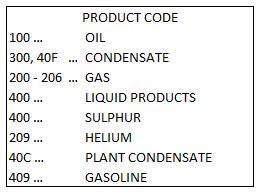Understanding oil and gas royalty statement product codes is the next step to becoming a better informed royalty owner.

The product code section of the statement, located in the upper right hand corner of our Example Royalty Statement (clickable link), identifies each source of revenue from the well of lease. It is unlikely, although possible, that a single well or lease generates revenue from each of the possible production products. Although I will discuss these products below, if you come across a product type or term I have not discussed, a great resource to research anything related to oil and gas is the Schlumberger Oilfield Glossary. You will most likely find that oil, natural gas, condensate, and plant liquids are the most common sellable products from an oil or gas well.
Royalty Statement Product Codes
Oil
Oil is one of the most common types of sellable products from a well or lease. It is generally, but not always, a dark liquid made up of many types of hydrocarbon molecules (chains of carbon and hydrogen atoms). Oil was formed when ancient micro-organisms, such as algae, were buried and exposed to extreme pressure and temperature for millions of years. Oil is sold by the barrel, which is equivalent to 42 gallons.
Condensate
Condensate is essentially light (low density) oil that is associated with natural gas production. As temperature and pressure decrease when natural gas reaches the surface in a well, some of the gas changes phase and becomes a liquid, which is referred to as condensate. Because of its slightly different chemical composition it often sells for a different price than crude oil.
Gas
Natural gas is probably the most common sellable product from a well or lease. Like oil, natural gas is also composed of many types of hydrocarbon molecules (chains of carbon and hydrogen atoms). Methane and ethane are the basic components of natural gas, although it usually is composed of propane, butane, and other molecules as well. It is colorless and odorless; however, a foul smelling substance called a mercaptan is added to the natural gas distributed to your home so that gas leaks can be identified. Although royalty statements generally report produced volume (Mcf or thousand standard cubic feet), natural gas is sold based on its energy or BTU content. The composition of the gas (amount of methane, ethane, propane, etc.) determines the energy content and value of the gas.
Liquid Products
This is really a catch-all description that can be used to describe any product that does not strictly meet any of the other definitions.
Sulphur
Sulphur is commonly associated with oil and gas production, particularly in the treatment of highly toxic hydrogen sulfide gas. Generally, it is a waste product that requires disposal. In some cases, however, there may be a demand for the product and it may be sold.
Helium
Just like natural gas, helium also is produced from wells. It is not particularly common to produce helium in an oil or gas well, but it is a very valuable product.
Plant Condensate
Plant condensate or NGLs (natural gas liquids) are terms for the liquids recovered from natural gas at a processing facility (rather than at the wellhead). Condensate or NGLs are sold by the gallon. The propane used in gas grills and the butane in lighters are types of plant condensates.
Gasoline
The term “natural gasoline” describes a hydrocarbon liquid with properties somewhere between those of condensate and plant liquids. Similar to the gasoline used in cars, it is very volatile. The “old timers” in the industry tell stories about how they used to fill up the gasoline tanks in their trucks with this product!

1 Comment